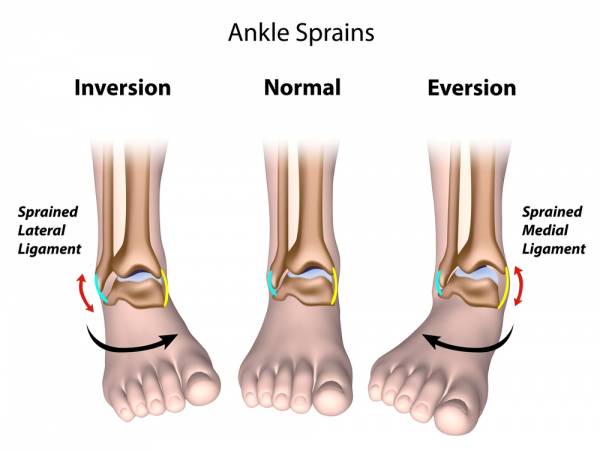Ankle sprains are one of the most common injuries for athletes and fitness enthusiasts alike. It has been estimated that roughly 25,000 people sustain this type of trauma each day.
The injury can occur while engaging in sports, from a simple fall, from “rolling” or “twisting” your ankle, or from stepping incorrectly off a curb or uneven surface. The mechanisms of this injury can be broad and all encompassing, and can mean a prolonged tenure of disability, if not adequately treated.
What Is an Ankle Sprain?
Knowing some basic physiology and anatomy can afford us a better understanding of this injury and its key anatomic players. The ligaments of the ankle attach bone to bone via their insertions and origins in the ankle. They also allow the ankle joint to have fluid, kinematic motion, which gives balance and stability to the ankle. As result, when these ligaments are injured, it can substantially affect an individual’s movement, balance, and stability.
There are many ligaments of the ankle, but here are some of the more commonly injured ones:
- Anterior talofibular ligaments
- Calcaneofibular ligament and the deltoid ligament
These ligaments and many others are essential for stabilizing the major bones of the ankle, including the talus, tibia, and fibula.

After a sprain occurs, it can be classified as Grade I, Grade II, or Grade III, depending on the severity of the ligament stretch, strain, or tear. Sometimes radiographs (x-rays) are taken to conclude that there is no fracture, subluxation, or dislocation, which may be difficult to determine if there is extensive swelling, bruising, and pain during the physical evaluation.
Treating the Injury
The basic treatments modalities include rest, ice, compression, and elevation (RICE), along with anti-inflammatory medication and immobilization, again depending on the severity of the injury.
But the major component of any ankle injury rehabilitation protocol should include a focused, strategic plan to fortify the proprioception of the ankle. Simply put, proprioception is the ability to know where your extremity is in space, relative to your own bodily movement. If you watch the attached video, I provide an in-depth explanation of this concept.
After an ankle injury, it is crucial that you re-train and re-strengthen your ankle. Often, when individuals suffer this injury, they can essentially lose a sense of where their ankle is relative to their basic body movements and surroundings. This can cause balance and stability issues, which can hinder your athletic performance and increase your chance of further injury.
I suggest the following ankle proprioception exercises, which may not only help to re-strengthen your ankle, but may also assist with re-enforcing your ankle proprioception and balance. These exercises are also demonstrated in the video.
- Ankle Flexion and Extension Exercises – These are geared toward strengthening your ankle and the muscles of the leg. I recommend 3 sets of 15.
- Ankle Circle Exercises – These can be done with or without a pulley or cable. Consider doing 3 sets of 15.
- Ankle Ball Rotations – These will strengthen and improve your proprioception as you roll the ball in multiple directions. I recommend 3 sets of 15 reps.
- Bosu Ball Standing Balance Exercises – These can be done with shoes on or off. The goal is to have multi –directional movement while standing on the ball. Ultimately, you want to feel stable and to have awareness about where your ankle is in space. Consider doing 3 sets of 15 reps.
- Bosu Ball Lunges – Side and front Bosu ball lunges may be quite challenging, yet they are essential in rebuilding your proprioceptive capacities, while also training your legs and core. Go at your own pace and listen to your body. The earlier exercises are an excellent platform for progressing to more difficult exercises like this Bosu ball lunge.
Consult A Professional
As an orthopedic surgeon, I am fortunate to treat patients with aggressive therapeutic modalities for reestablishing proprioception strength and a sense of wellness. I hope these exercises are helpful to you, too. Be sure to consult your physician before conducting this or any other exercise program.
If you find that you have any specific questions regarding the aforementioned anatomical components or exercises feel free to post your questions on the forums and I will answer them as soon as I can.
More on the ankle:
- Fix Your Weak Foundation: Your Ankles
- 2 Drills to Injury Proof Your Ankles
- Effects of Ankle Taping on Performance and Safety
- What’s New On Pulse Beat Fit Today
Photos courtesy of Shutterstock.






